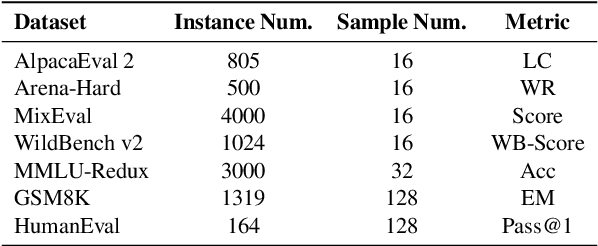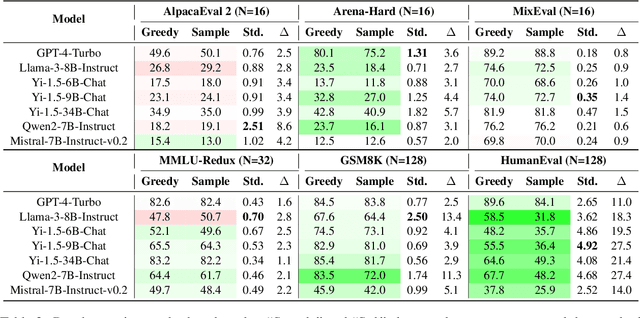Sujian Li
FinRAGBench-V: A Benchmark for Multimodal RAG with Visual Citation in the Financial Domain
May 23, 2025Abstract:Retrieval-Augmented Generation (RAG) plays a vital role in the financial domain, powering applications such as real-time market analysis, trend forecasting, and interest rate computation. However, most existing RAG research in finance focuses predominantly on textual data, overlooking the rich visual content in financial documents, resulting in the loss of key analytical insights. To bridge this gap, we present FinRAGBench-V, a comprehensive visual RAG benchmark tailored for finance which effectively integrates multimodal data and provides visual citation to ensure traceability. It includes a bilingual retrieval corpus with 60,780 Chinese and 51,219 English pages, along with a high-quality, human-annotated question-answering (QA) dataset spanning heterogeneous data types and seven question categories. Moreover, we introduce RGenCite, an RAG baseline that seamlessly integrates visual citation with generation. Furthermore, we propose an automatic citation evaluation method to systematically assess the visual citation capabilities of Multimodal Large Language Models (MLLMs). Extensive experiments on RGenCite underscore the challenging nature of FinRAGBench-V, providing valuable insights for the development of multimodal RAG systems in finance.
KNN-SSD: Enabling Dynamic Self-Speculative Decoding via Nearest Neighbor Layer Set Optimization
May 22, 2025Abstract:Speculative Decoding (SD) has emerged as a widely used paradigm to accelerate the inference of large language models (LLMs) without compromising generation quality. It works by efficiently drafting multiple tokens using a compact model and then verifying them in parallel using the target LLM. Notably, Self-Speculative Decoding proposes skipping certain layers to construct the draft model, which eliminates the need for additional parameters or training. Despite its strengths, we observe in this work that drafting with layer skipping exhibits significant sensitivity to domain shifts, leading to a substantial drop in acceleration performance. To enhance the domain generalizability of this paradigm, we introduce KNN-SSD, an algorithm that leverages K-Nearest Neighbor (KNN) search to match different skipped layers with various domain inputs. We evaluated our algorithm in various models and multiple tasks, observing that its application leads to 1.3x-1.6x speedup in LLM inference.
MPO: Boosting LLM Agents with Meta Plan Optimization
Mar 04, 2025Abstract:Recent advancements in large language models (LLMs) have enabled LLM-based agents to successfully tackle interactive planning tasks. However, despite their successes, existing approaches often suffer from planning hallucinations and require retraining for each new agent. To address these challenges, we propose the Meta Plan Optimization (MPO) framework, which enhances agent planning capabilities by directly incorporating explicit guidance. Unlike previous methods that rely on complex knowledge, which either require significant human effort or lack quality assurance, MPO leverages high-level general guidance through meta plans to assist agent planning and enables continuous optimization of the meta plans based on feedback from the agent's task execution. Our experiments conducted on two representative tasks demonstrate that MPO significantly outperforms existing baselines. Moreover, our analysis indicates that MPO provides a plug-and-play solution that enhances both task completion efficiency and generalization capabilities in previous unseen scenarios.
Chain-of-Thought Matters: Improving Long-Context Language Models with Reasoning Path Supervision
Feb 28, 2025Abstract:Recent advances in Large Language Models (LLMs) have highlighted the challenge of handling long-context tasks, where models need to reason over extensive input contexts to aggregate target information. While Chain-of-Thought (CoT) prompting has shown promise for multi-step reasoning, its effectiveness for long-context scenarios remains underexplored. Through systematic investigation across diverse tasks, we demonstrate that CoT's benefits generalize across most long-context scenarios and amplify with increasing context length. Motivated by this critical observation, we propose LongRePS, a process-supervised framework that teaches models to generate high-quality reasoning paths for enhanced long-context performance. Our framework incorporates a self-sampling mechanism to bootstrap reasoning paths and a novel quality assessment protocol specifically designed for long-context scenarios. Experimental results on various long-context benchmarks demonstrate the effectiveness of our approach, achieving significant improvements over outcome supervision baselines on both in-domain tasks (+13.6/+3.8 points for LLaMA/Qwen on MuSiQue) and cross-domain generalization (+9.3/+8.1 points on average across diverse QA tasks). Our code, data and trained models are made public to facilitate future research.
LongAttn: Selecting Long-context Training Data via Token-level Attention
Feb 24, 2025Abstract:With the development of large language models (LLMs), there has been an increasing need for significant advancements in handling long contexts. To enhance long-context capabilities, constructing high-quality training data with long-range dependencies is crucial. Existing methods to select long-context data often rely on sentence-level analysis, which can be greatly optimized in both performance and efficiency. In this paper, we propose a novel token-level framework, LongAttn, which leverages the self-attention mechanism of LLMs to measure the long-range dependencies for the data. By calculating token-level dependency strength and distribution uniformity of token scores, LongAttn effectively quantifies long-range dependencies, enabling more accurate and efficient data selection. We filter LongABC-32K from open-source long-context datasets (ArXiv, Book, and Code). Through our comprehensive experiments, LongAttn has demonstrated its excellent effectiveness, scalability, and efficiency. To facilitate future research in long-context data, we released our code and the high-quality long-context training data LongABC-32K.
More Tokens, Lower Precision: Towards the Optimal Token-Precision Trade-off in KV Cache Compression
Dec 17, 2024Abstract:As large language models (LLMs) process increasing context windows, the memory usage of KV cache has become a critical bottleneck during inference. The mainstream KV compression methods, including KV pruning and KV quantization, primarily focus on either token or precision dimension and seldom explore the efficiency of their combination. In this paper, we comprehensively investigate the token-precision trade-off in KV cache compression. Experiments demonstrate that storing more tokens in the KV cache with lower precision, i.e., quantized pruning, can significantly enhance the long-context performance of LLMs. Furthermore, in-depth analysis regarding token-precision trade-off from a series of key aspects exhibit that, quantized pruning achieves substantial improvements in retrieval-related tasks and consistently performs well across varying input lengths. Moreover, quantized pruning demonstrates notable stability across different KV pruning methods, quantization strategies, and model scales. These findings provide valuable insights into the token-precision trade-off in KV cache compression. We plan to release our code in the near future.
VLRewardBench: A Challenging Benchmark for Vision-Language Generative Reward Models
Nov 26, 2024



Abstract:Vision-language generative reward models (VL-GenRMs) play a crucial role in aligning and evaluating multimodal AI systems, yet their own evaluation remains under-explored. Current assessment methods primarily rely on AI-annotated preference labels from traditional VL tasks, which can introduce biases and often fail to effectively challenge state-of-the-art models. To address these limitations, we introduce VL-RewardBench, a comprehensive benchmark spanning general multimodal queries, visual hallucination detection, and complex reasoning tasks. Through our AI-assisted annotation pipeline combining sample selection with human verification, we curate 1,250 high-quality examples specifically designed to probe model limitations. Comprehensive evaluation across 16 leading large vision-language models, demonstrates VL-RewardBench's effectiveness as a challenging testbed, where even GPT-4o achieves only 65.4% accuracy, and state-of-the-art open-source models such as Qwen2-VL-72B, struggle to surpass random-guessing. Importantly, performance on VL-RewardBench strongly correlates (Pearson's r > 0.9) with MMMU-Pro accuracy using Best-of-N sampling with VL-GenRMs. Analysis experiments uncover three critical insights for improving VL-GenRMs: (i) models predominantly fail at basic visual perception tasks rather than reasoning tasks; (ii) inference-time scaling benefits vary dramatically by model capacity; and (iii) training VL-GenRMs to learn to judge substantially boosts judgment capability (+14.7% accuracy for a 7B VL-GenRM). We believe VL-RewardBench along with the experimental insights will become a valuable resource for advancing VL-GenRMs.
AgentBank: Towards Generalized LLM Agents via Fine-Tuning on 50000+ Interaction Trajectories
Oct 10, 2024



Abstract:Fine-tuning on agent-environment interaction trajectory data holds significant promise for surfacing generalized agent capabilities in open-source large language models (LLMs). In this work, we introduce AgentBank, by far the largest trajectory tuning data collection featuring more than 50k diverse high-quality interaction trajectories which comprises 16 tasks covering five distinct agent skill dimensions. Leveraging a novel annotation pipeline, we are able to scale the annotated trajectories and generate a trajectory dataset with minimized difficulty bias. Furthermore, we fine-tune LLMs on AgentBank to get a series of agent models, Samoyed. Our comparative experiments demonstrate the effectiveness of scaling the interaction trajectory data to acquire generalized agent capabilities. Additional studies also reveal some key observations regarding trajectory tuning and agent skill generalization.
Shapley Value-based Contrastive Alignment for Multimodal Information Extraction
Jul 25, 2024



Abstract:The rise of social media and the exponential growth of multimodal communication necessitates advanced techniques for Multimodal Information Extraction (MIE). However, existing methodologies primarily rely on direct Image-Text interactions, a paradigm that often faces significant challenges due to semantic and modality gaps between images and text. In this paper, we introduce a new paradigm of Image-Context-Text interaction, where large multimodal models (LMMs) are utilized to generate descriptive textual context to bridge these gaps. In line with this paradigm, we propose a novel Shapley Value-based Contrastive Alignment (Shap-CA) method, which aligns both context-text and context-image pairs. Shap-CA initially applies the Shapley value concept from cooperative game theory to assess the individual contribution of each element in the set of contexts, texts and images towards total semantic and modality overlaps. Following this quantitative evaluation, a contrastive learning strategy is employed to enhance the interactive contribution within context-text/image pairs, while minimizing the influence across these pairs. Furthermore, we design an adaptive fusion module for selective cross-modal fusion. Extensive experiments across four MIE datasets demonstrate that our method significantly outperforms existing state-of-the-art methods.
The Good, The Bad, and The Greedy: Evaluation of LLMs Should Not Ignore Non-Determinism
Jul 15, 2024



Abstract:Current evaluations of large language models (LLMs) often overlook non-determinism, typically focusing on a single output per example. This limits our understanding of LLM performance variability in real-world applications. Our study addresses this issue by exploring key questions about the performance differences between greedy decoding and sampling, identifying benchmarks' consistency regarding non-determinism, and examining unique model behaviors. Through extensive experiments, we observe that greedy decoding generally outperforms sampling methods for most evaluated tasks. We also observe consistent performance across different LLM sizes and alignment methods, noting that alignment can reduce sampling variance. Moreover, our best-of-N sampling approach demonstrates that smaller LLMs can match or surpass larger models such as GPT-4-Turbo, highlighting the untapped potential of smaller LLMs. This research shows the importance of considering non-determinism in LLM evaluations and provides insights for future LLM development and evaluation.
 Add to Chrome
Add to Chrome Add to Firefox
Add to Firefox Add to Edge
Add to Edge